|
Co-author : Yuri
Yashnev (Moscow)
Short Historical
Note
When in 1945 the USSR joined in the war
against Japan, the Mongolian People's Republic (M.P.R.) added some of its forces to the
attack and thus became a WW2 participant.
- The Gold Star Medal (Hero of the
M.P.R.)
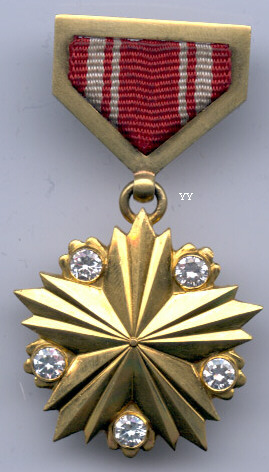
- As the awards title suggest, this Gold Star is bestowed on
the Heroes of the MPR. This title was introduced in the People's Revolution in 1921.
Damdiny Suche-Bator was the first recipient (23 September 1922). Different titles were
used, the first variant being "The Intrepid Hero of the Mongolian People's
State". Afterwards, in 1924, this became "The Unbending Hero of People".
Next the title changed to "Tried and Tested in Battle Hero of People". Marshal
Choybalsan received this latter title (10 July 1941).
The title "Hero of the MPR" was properly instituted 5 October 1941 by a decree
in the Khural (Parliament). All previous titles were rendered obsolete and their
recipients adopted the new title.
The Gold Star Medal itself was instituted 17/10/1945, after WW2, and all previous Heroes
received it as well as, simultaneously, the Order of Suche Bator order and a special
diploma.
Multiple awards are possible and, in such a case the title is changed to "Twice Hero
of the MPR" and a Hero's Monument is erected in the recipient's birthplace. Only once
has a double award been made : to Field-Marshal Choybalsan (second award on 20 September
1945).
Heroes of the MPR have the same privileges as for recipients of the Order of Suche-Bator
(see below) and are furthermore, exempted from paying taxes.
Not only Mongolians could receive this award and 17 Russians were also so honoured. Among
them well-known names such as Stalin, Field-Marhals Zhukov, Voroshilov and Konev. Soviet
President Brezhnev was also among the recipients.
The Star is made of solid gold and has five 0.25 carat diamonds mounted on it. Dimensions
: 55 x 32 mm. Weight : 42.60 g.
-
- As mentioned above, the title "Hero of the MPR"
was decided upon in 1941 (5 October) and between that day and the institution of the Gold
Star Medal a special medal was made for the persons so honoured to display. Only 10 were
ever awarded !
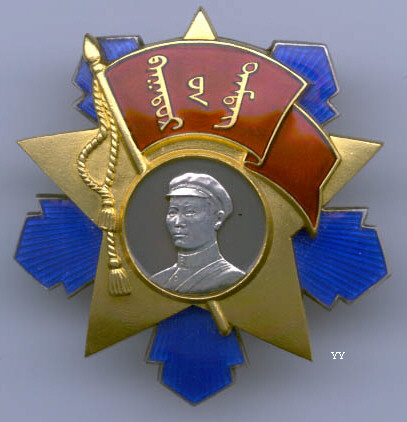
-
-
-
-
- The Order of Suche Bator

- This highest order of Mongolia was instituted 16/05/1941. It
was awarded to thousands of Mongolians and foreigners for military and civil services.
Multiple awards were made, i.e. Field-Marshal Tsedenbal (Zedenbal?), 6 times -
Colonel-General Tsog (Zog?), 5 awards ) - Field-Marshal Choybalsan, a number of Mongolian
generals and Field-Marshal Zhukov (Russia) received the order three times.
The order brought a number of privileges to its recipients : free visits to museums,
public shows, cinema, etc., free education (sometimes abroad) for their children, free
hunting and fishing wherever on the Mongolian territory, including national parks and
preserves.
Before 1961 the order had no ribbon but instead a special small enameled rectangle
was worn on undress uniform. Its colors were yellow (2.5 mm), light blue (3 mm), light
blue/white ornament (4 mm), red (9 mm), light blue/white ornament (4 mm), light blue (3
mm), yellow (2.5 mm).
In 1961 this was changed into a ribbon : blue (4 mm), white (4 mm), dark red (8 mm), white
(4 mm), blue (4 mm).
The order has two types: type I - screwback, type II - with reverse pin.-
-
-
- The Order of the Red Banner of
Combat
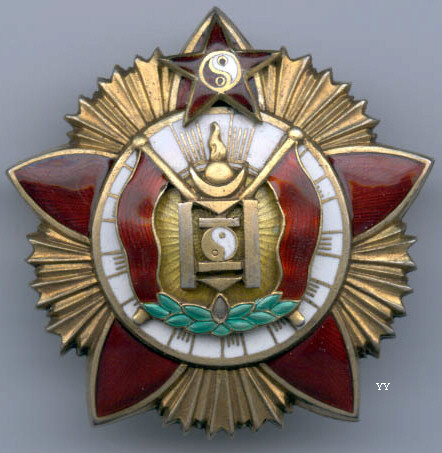 |
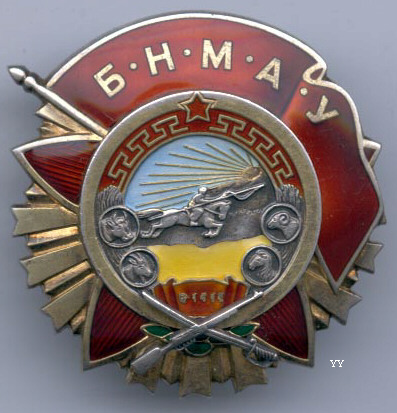 |
| 1st type (1926) |
Second type (1940) |
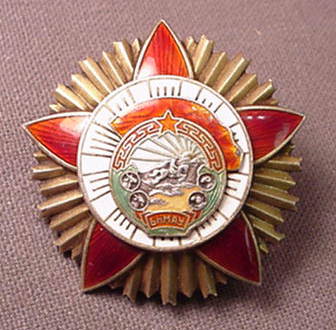 |
| Third type (1945) |
- Breast star instituted in 1926. Although
not a WW2 instituted award it is included here as it was awarded during the period
concerned. Third and fourth types of this order were awarded after the war (1945 and
1970).
- This is the first order created by the MPR. It's original
name was "The Order for Military Valor". After 1940 it became "The Red Banner for Military Valor" and adopted its current name on 17 October 1945. The
order is in gilded silver.
It is bestowed for military services and strengthening the Armed Forces.
Multiple awards to the same recipient are shown by a blue plaque with a white number
"2", "3" or "4" in the lower part of the badge. Such awards
include : Field-Marshals Damid and Choybalsan, Colonel-General Lhagwasuren - 4 times,
Major-Generas Erendoo, Damdinkhu and Danzan, Colonels Nyantaysuren and Tsedendash - 3
times.
Among the Russian recipients are Field-Marshal Voroshilov and Field-Marshal Budyonny.
- The order could also be awarded to military units and many
were so honoured.
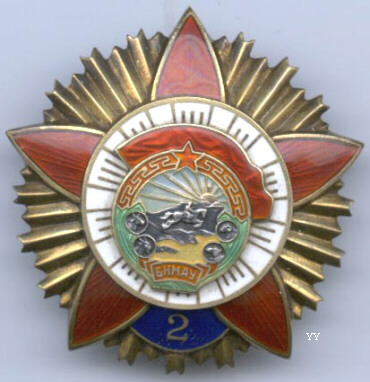 |
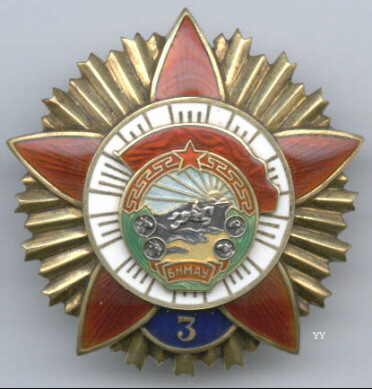 |
| Double award - 3rd type (1945) |
Triple award - 3rd type (1945) |
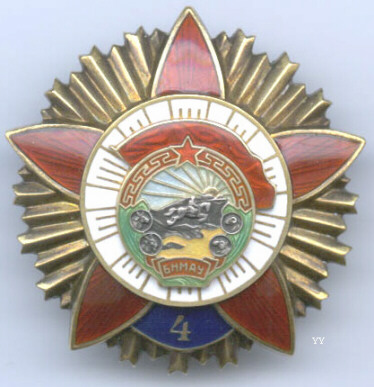 |
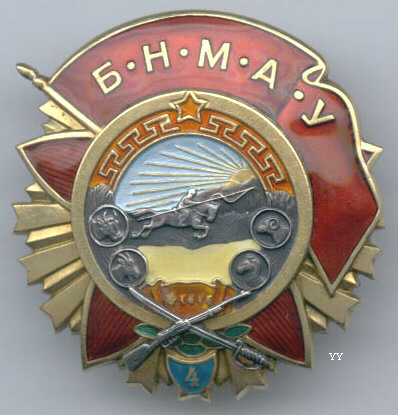 |
| Quadruple award - 3rd type (1945) |
Quadruple award - 2nd type (1940) |
The current service dress ribbon is red (8 mm), light blue
(8 mm), red (8 mm) while at first this was a small metal enameled rectangle of yellow (4
mm), red (6 mm), white (1 mm), white/blue ornament (6 mm), white (1 mm), red (6 mm),
yellow (4 mm).
-
-
- The Order of the Polar Star
- Instituted in 1936, it is the most common order for civil
and military services. This order is sometimes
referred to as the Order of the Pole Star as well.
- There are four known types in existence
and the first two
depicted above are the first and second
models, as awarded from 1936 to 1939 and 1939/40 till 1941 respectively. Numbers awarded
are, approximately 300 for the 1st type, some 2,000 for the 2nd type and about 12,000 and
16,000 respectively for models 3 and 4. The 2nd and 3rd types are exactly the
same except that the Uigurian alphabet is used in the Mongolian coat of the arms in the
2nd type whereas the 3rd type has Cyrillic lettering.
The current undress ribbon is olive-colored (8 mm), yellow (8 mm), olive-colored (8 mm).
Earlier a small metal enameled rectangle was worn. Its colours were : yellow (3 mm), blue
(7 mm), yellow (1 mm), yellow/red ornament (6 mm), yellow (1 mm), blue (7 mm), yellow (3
mm).
-
-
- The Medal for Combatant Merit
-
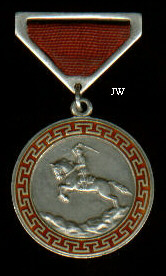
This medal was instituted on 16 May 1941 and
several thousands were awarded. Sometime in the
1950's the material used changed from silver to white metal.
The current undress ribbon is red (8 mm),
purple (8 mm), red (8 mm). Before there was a small metal enameled rectangle of yellow (3
mm), white/light blue ornament (5 mm), red (2 mm), white (1 mm), blue (6 mm), white (1
mm), red (2 mm), white/light blue ornament (5 mm), yellow (3 mm).
-
- The Order for Combatant Merit
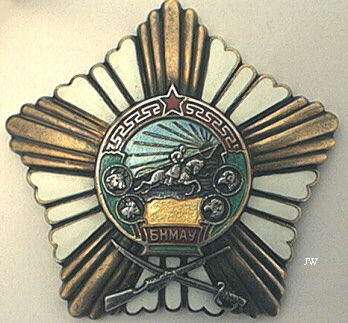
- Instituted on 17 October 1945 in
one class. This decoration was awarded for outstanding merit in action and could be
bestowed on military units as well as on individuals. Its service dress ribbon consists of
three equal 8 mm stripes of white, red and white.
The earlier variant of small metal enameled rectangle used had the following colour
combination : yellow (3 mm), light blue/white ornament (5 mm), yellow (1 mm), red (1 mm),
yellow (1 mm), blue (6 mm), yellow (1 mm), red (1 mm), yellow (1 mm), light blue/white
ornament (5 mm), yellow (3 mm).
-
- The "We Have
Conquered" Medal
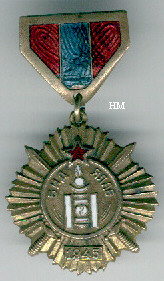
- Also instituted in 1945, this medal was
awarded to both military and civilian participants who assisted in the fighting against
"Japanese imperialistic agression". Some 10,000 are supposed to be awarded to
Mongolian soldiers and civilians and also USSR personnel is believed to have received this
medal.
-
-
- The Medal for the 30th
Anniversary of the Defeat of Militant Japan
 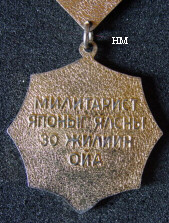
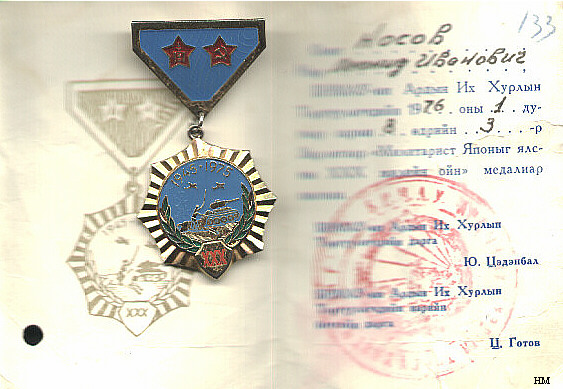
Instituted in 1975.
The Honour Medal
of Labour
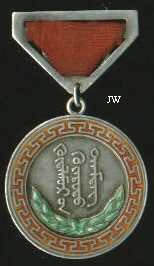 |
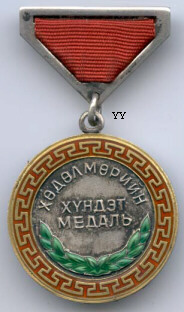 |
| Type 1 (May 1941) |
Type 2 (End 1941) |
The first type of this medal, using the Uigur alphabet, was
instituted on 26 May 1941 as an award for distinguished labour and can be considered as
the common award for the homefront labour force in WW2. The second type was created at the
end of the same year, using the Cyrillic alphabet. As Mongolia was the biggest
"foreign" supplier of meat, sheepskin winter coats and cavalry horses for the
Soviet Red Army, many an award for WW2 labour was made.
The Chalkin Gol
Medals
These medals commemorate a conflict just prior
to WW2 but I've included them here as the adversaries met again during the war and the
actual award of the first medal did take place in 1940.
Chalkin Gol is a Mongolian river that lent its
name to the conflict between Mongolia and Japan which started on 11 May 1939 and lasted to
the end of August of that year. Japanese troops invaded the MPR near this river and both
Russian and Mongolian armies, under the overall command of then General Zhukov, gave them
a beating. The first medal was awarded in 1940 and got official medal status on 29
December 1966. It is the only Mongolian award that has Latin script as it was awarded
during a short, 6 month period, in which Mongolia used the Latin alphabet.
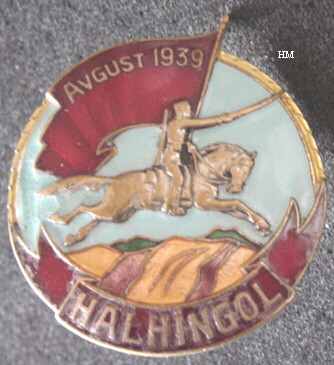
Two other medals were struck in commemoration
of the conflict. One for the 30th and one for the 40th anniversary (officially known as
the Chalkin Gol Victory Medal).
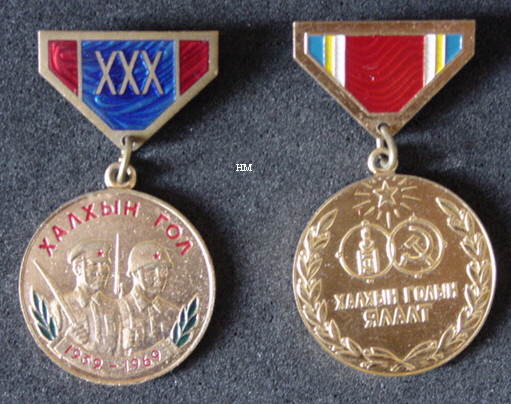
|